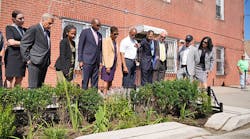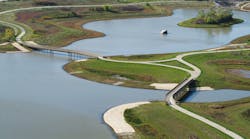Jan. 13, 2014 -- A federal judge has approved and entered a consent decree for Metropolitan Water Reclamation District of Greater Chicago's (MWRD) long-term control plan more than two years after the company and the United States District Court reached an agreement.
Originally filed in Dec. 2011, there were two groups of intervenors that opposed the entry of the proposed consent decree. Two of the issues raised by these groups were the length of the Tunnel and Reservoir Plan (TARP) construction schedule and the amount of green infrastructure (GI) included in the decree.
"Tremendous public-works projects can take a significant amount of time -- even decades -- to complete," said Judge George M. Marovich, the arbitrator of the decree. "TARP is no small project. It has involved creating more than 100 miles of tunnels and mining rough holes that will eventually be large enough to hold 17.5 billion gallons of water. By the time TARP is finished, MWRD will have added an average of 323,000,000 gallons of storage capacity per year, which is an average of 885,000 gallons per day of additional storage capacity."
One section of the consent decree is designed to foster the use of GI controls, which are relatively new technologies that help reduce the amount of stormwater that flows into the sewer system during a storm. The MWRD will implement GI controls that capture, on a per-storm-event basis, 2 MG of capacity five years after the effective date, 5 MG 10 years after the effective date, and 10 MG 15 years after effective date. The opinion recognizes that GI projects are not mandated as part of the TARP plan and are not required by any law.
The consent decree provides an enforceable schedule for implementing MWRD's TARP, which will result in a significant decrease in the volume of water discharged to the waterways from combined sewer overflows (CSOs) in Cook County, along with dramatically reducing the potential for flooding. MWRD is committed to executing this work as quickly as possible.
MWRD, along with state and local officials, conceived TARP in the early 1970s as the appropriate means to control CSOs, mitigate flooding, and protect water quality in the Chicagoland area. The plan was conceived before current laws requiring CSO controls went into effect. The TARP plan was enacted decades before its time and remains a model for cities throughout the U.S. and the world.
###


